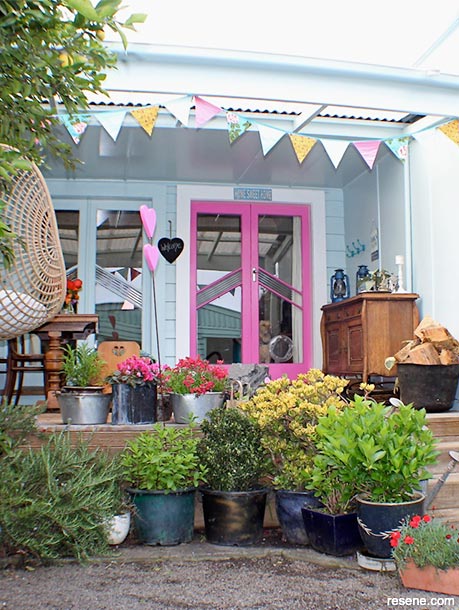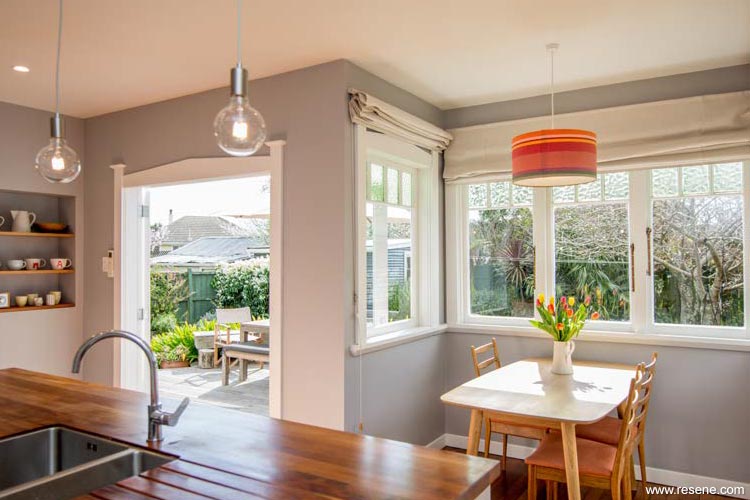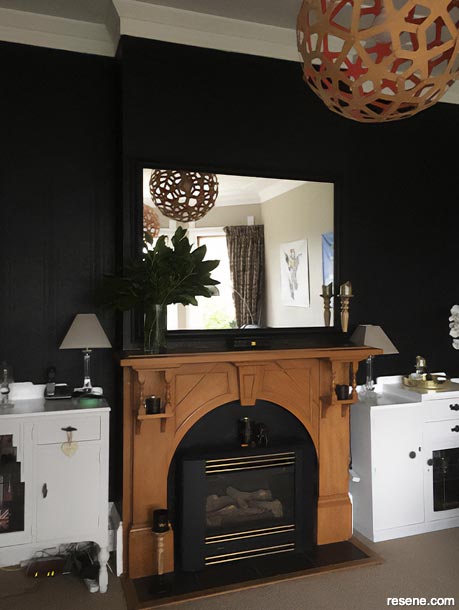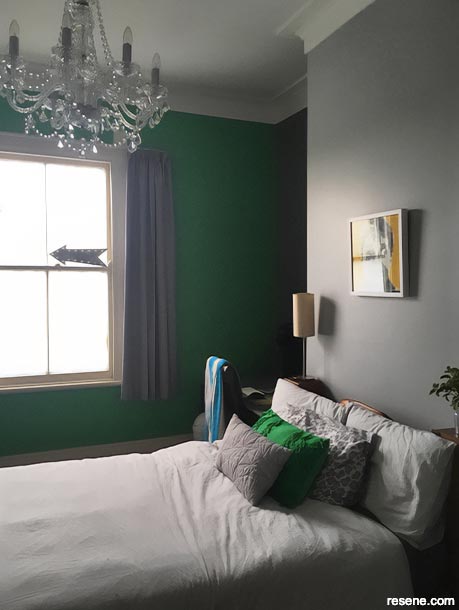From the Resene decorating blog
Learn how to bring out the best in your villa, bungalow or character home with paint.

A 'boho beauty' cottage painted in Resene Jungle Mist, Resene Bounce, Resene Smitten, Resene Free Spirit and Resene Black White. View project...
In the early 1990s, in conjunction with leading conservation architect Ian Bowman, Resene developed a set of colour guidelines that reflect the various historical periods of home design – the Resene Heritage Colour Chart. These colours reflect the authentic heritage colours originally used on heritage homes and buildings throughout New Zealand.
It’s been a long and interesting journey since that time with many innovations and improvements along the way. Getting started is sometimes the hardest part of any journey, however we hope this advice will help you on your way with tips, advice and information relevant to painting your place, and preserving your own corner of New Zealand history.
Safety
Areas that impact on health and safety or ones that will cause other damage need to be addressed first. Some examples are a leaking roof or rotten flooring.
Don’t skip steps
Don’t be tempted to paint the wall when the wall linings need repair, the house needs to be repiled, or the windows need replacing. Sometimes you need to spend time and money on the boring bits first!


How to prioritise
Which item on your renovating list is going to make the biggest difference to your day to day life? Where do you spend the most waking hours in your villa or bungalow? Focus on these areas first, usually the living areas and the garden.
Create a checklist and cost guide
Write down everything that needs renovating, with a cost estimate next to it. Allow for at least a 10-20% contingency fund.
Allow for knock on effects
Identify as many as you can so you can mitigate these or be prepared for them. For example, when you rip out that bathroom wall, you may discover the wiring behind it is damaged, it needs new insulation or the timber structure behind it needs replacing.
Ripping out old bathrooms and kitchens
Is it structural? Building consents cost time and money (sometimes a lot of money!) – check if you need one first by looking at your local council's website or giving them a call. It may be worth focusing on another project first.
The good news
The good news is that painting is one of the most cost effective improvements you can make to your home. For a relatively low investment the results can be transformational improving the day to day enjoyment of your home. Even if you are planning more extensive renovations, sometimes painting the walls in the meantime will be enough to make your home feel more like home while other areas of your home are being renovated.


Develop a theme
Contemporary or traditional? Formal, romantic, country? Whichever way you go, ensure you are consistent with the theme. If you are striving for a traditional home use materials, textures, and colours that are true to this style. Many character homes can have either a contemporary or traditional themed interior, and both can look great.
Villas and bungalows tend to have traditional exteriors, particularly on the street frontage where their best features are. 1950s – 1970s homes often have the box shape to look great totally modernised with aluminum joinery and plaster, however this won’t look so great on the exterior of your 1910 villa.
Maintaining a theme throughout the exterior and interior of your home will help you develop a harmonious and balanced living environment. Once you have selected a theme, future purchasing decisions will be simplified since the theme will guide your decisions.
Harmonise with the environment
A good home should complement the site and environment. It shouldn’t look out of place with neighbouring homes and this is why many councils have introduced heritage zones.
For example, say you need to build a fence and you are unsure of what kind of fence to build. Think about your theme from tip one above and then take a look at the rest of the homes in your street. What kind of fences do they have? Will your fence look out of place? A brightly painted character home and aluminium fence may look out of place in a street full of neutrally painted villas with picket fences.
Accent the positive
Use accents on your home’s exterior and in each interior room. Aim for a focal point in each area and develop the room or exterior around this.
Typically, the focal point in a dining room would be the table, in a bedroom it would be the bed and duvet, while the exterior may be the brightly painted front door. High ceilings are always a sought after feature in villas and bungalows.
Go with the flow
A good home is designed to allow easy movement for one area to another, usually dictating that like rooms should be located in clusters. Living areas such as the kitchen, dining and lounge should be close together and the bedrooms should all be in the same wing of the house.
Decide on the extent of your project before you start and break it down into manageable steps you can afford financially and time wise. Otherwise you will be surrounded by paint cans, half stripped wallpaper and jobs half done.
Who lives there?
Ultimately a good home feels good to the people living there. Don’t be afraid to go with your own sense of style and conviction, after all you are the person who will have to live there.


Painting your home, DIY or pay a professional?
Sometimes it may seem a lot cheaper to DIY, rather than to pay a professional, but have a think about the following:
DIY
Just how exactly, were you going to reach the top of that steeply pitched roof or 10ft high ceiling?
Professional
Has been there, done it all before. Is aware of the risks and has the experience and materials to mitigate the risks.
Notes
Painting can be dangerous and/or hazardous. Working on ladders and dealing with solvents and dusts can be hazardous. Older houses may be coated in poisonous lead based paints.
DIY
Which paint or primer do I need?
Professional
Knows all the tricks of the trade when it comes to painting character homes.
Notes
Painting is a skilled trade that requires training and appropriate tools.
DIY
How confident are you that your preparation will ensure a high quality finish?
Professional
Knows how to properly prepare the surface, which paints to use in each situation
Notes
It takes considerable expertise and experience to get a truly high quality finish.
DIY
Professional
Already has the materials required to do the job.
DIY
Scaffolding hire, petrol, trailer
Professional
Already has the necessary add ons or knows where to get them. All included in the quote.
DIY
3 times as long as a professional!
Notes
Can your time be better spent on another pending project?
If you do decide to tackle your project yourself, ask our Resene ColorShop staff for recommendations from surface preparation to finish coats – that way you’ll be doing it right first time and will save yourself having to redo parts.


Word of mouth
This is often the best way to find a good painter. Ask friends, family and neighbours who have had similar work done recently for recommendations.
Experience
Experience counts, not only in number of years on the job, but how many villas, bungalows or character homes like yours has the painter completed?
Professional Associations
Check the Resene Eco.Decorator list, try the Resene Find-A-Painter service or your local Master Painters trade association – all can help you make contact with professional painters.
Price
Never select a painter on price alone, the cheapest quote is seldom the best value in the long run. If there is a wide variance in the quotes received ask for a breakdown from each painter.
Assess the initial service you get from each painter and how efficient and effective it seems. This will be a guide to the service you receive once you hire the painter. Negotiating a low rate may be a false economy if the painter cuts corners to get the job done quickly.
Qualifications
Always check painters are qualified to do the work.
References
Ask for the names of other character homeowners for references – and make sure you check them out. If possible, visit the completed job so you can assess the quality, and ask questions such as:


Write down your goals
Be clear about what you want to achieve – put it in writing and give a copy to painters who are quoting for the job.
Get it in writing
Get a quote from the painter in writing. The quote should include:
Completing the quote
Once agreed to, the quote should be signed and dated by both yourself and the painter.
Payment terms
Agree on payment terms and get it in writing. While it is common for the customer to pay an initial deposit for materials and/or installments as the work progresses, never pay for the entire job in advance. Agree on a schedule of payments as key work is completed. The final payment should not be made until the entire job is complete and has been carefully inspected.
Unforeseen additional work
Any extra work that arises once the project is underway must be specified, priced and agreed in writing before the work is undertaken and any costs are incurred. Only make payments by cheque, not cash, so there is a paper trail should disputes over payment occur.
Be realistic
Be realistic about the amount and time you have budgeted for a good painter. Good painters are in demand and will therefore usually charge more that the market average and are unlikely to be able to start immediately.
Visit the Resene website for tools like the online colour library, Find-a-Colour and EzyPaint virtual painting software that enables you to virtually paint your home so you can see what it will look like once painted. See the Resene Heritage colour chart (online) for traditional colours and palettes to help you get started. View a PDF of the chart...
Visit your local Resene ColorShop
Have a chat to the staff about your home. They may have seen rooms painted in colours you like and will know how it looks en masse, which is often quite different to a colour chart.
Applying test colours
Buy at least three different Resene testpots. Even if you have your heart set on one neutral colour, try it in half and quarter tones.
The colour always looks different in large amounts so always paint onto a large piece of cardboard leaving a border around the edge so you can move the colour around the space and see how it would look.
Keep the different test colours next to each other on the wall. It is easier to compare them – and keep them in the same order, rather than painting different colours on different walls.
Paint the testpots alphabetically by the paint colour name, from left to right, in each room so you don’t get confused.
Viewing test colours
View the test patches for at least a week before making a decision so you get used to them, and you can view them in different lights and at various times of the day. Live with them for a while.
Stick to the theme
Ensure consistency between the exterior colour of your home and interiors. For example, earthy browns and creams, or greys?
Stick to the basics
If in doubt stick to the neutral and earthy colours (Resene Pearl Lusta and Resene Spanish White have been best-selling colours since they were launched more than 40 years ago). You can liven up the rooms with splashes of colours with cushions, rugs, light fittings, vases and artwork.
Consider using a colour consultant
The peace of mind that comes with knowing you have made the right colour decision can be a good investment.
Minimise stress
Use an expert to take the hassle out of the decision for you, or to present you with some easy choices
Be confident you have made the right decision
A colour consultant has seen many houses and colour schemes, using their experience can give you the confidence in your colour decisions.
Tie all the colours in your home together
You may like different colours, but do they work together? A colour consultant’s trained eye will ensure you have the right tones and shades to match throughout your home.
Expand your boundaries
A colour consultant can help you explore broader colour options with confidence and bring together your favourite colour options into a harmonious palate.
Free advice?
It’s a free service available at selected Resene ColorShops. Book online.
Check which paints go where with Resene recommended painting systems.
Check how much paint you need with the Resene Paint Calculator.
Check you have everything you need with the Resene painting checklist.
When it comes to choosing paint:
Check out our tips about how to paint with a brush or roller.


Always fully prep first, follow the guidelines in the Resene recommended painting systems guide. The better the prep, the better the final paint job.
Paint top down, ceiling first, floor last.
Cut in – Using a brush, paint straight horizontal 4 cm width lines between the ceiling and wall, and the skirting and wall. If you are right handed work from left to right so you have good visibility.
Painting windows – If you are painting windows, you can mask them or with care use a razor blade to remove any paint that ends up on the glass panes – make sure you don’t scratch the glass.
Skirting boards are often the last thing you paint. Ensure carpet is adequately protected and clean so dust does not cover the new paint. A piece of cardboard or a flat baking oven tray provide good protection for the carpet and help to ensure a straight smooth edge. Cut in from the top of the board. Paint the bottom edge of the board. Do the middle last. Don’t rush, take your time.
If you can’t easily remove them, cover door and drawer handles with clear cling wrap before painting. If you can remove them, you can also replace them with another style if you wish to change the look.
Save washing up – There is no need to clean brushes and rollers at the end of each day – put them into a tightly sealed plastic bag in a cool place. The paint will stay moist and you can start using them the next day.
Buy only the paint you need.
The best way to save waste is to avoid buying too much. Use the Resene Paint Calculator and check with Resene ColorShop staff how much paint you need. Make sure you put on the right amount of paint – too thin and it won’t protect as well.
Use up all your paint
Left over paint can be used for touch up jobs, or an extra coat or base coat. Waterborne paints are ideal for creating signs and banners.
Donate left over paint
Consider donating the leftover paint to your local school or childcare centres. Make sure you donate it while the paint is still in good condition so it can be used.
Recycle the empty paint container
Allow the contents of the empty paint can to dry out. Take it to a Resene PaintWise Collection Centre with the lid off so the staff can see it is dry and empty. Each paint container you recycle is one less container that ends up in landfill.
Reuse packaging materials
Larger paint containers (10 litre) make ideal substitutes for buckets. Smaller ones can be used for paint pots or money boxes.
April 17, 2016
Visit your local Resene ColorShop for expert advice and all the products and accessories you need to make the most of your home.
Book a colour consult | Ask a Colour Expert | Ask a Paint Expert
Resene's decorating blog
Paint your home beautiful! Discover the latest decorating trends, tips and colour news.
![]()
Previous «
How to use plants to help your interior look green and stay clean
![]()
Blog home
View the latest trends, tips and news
![]()
» Next
Feature walls